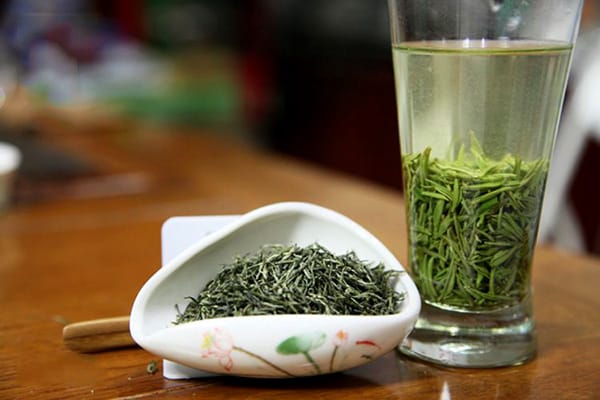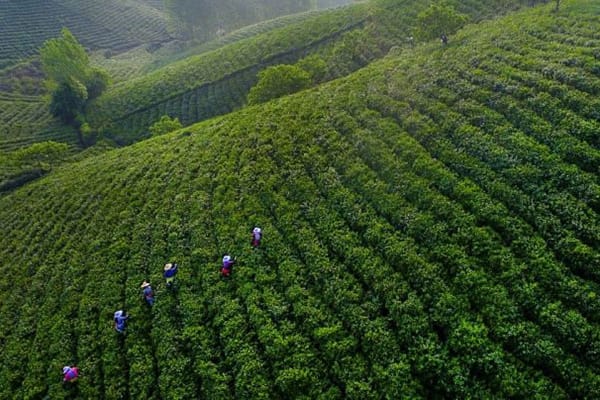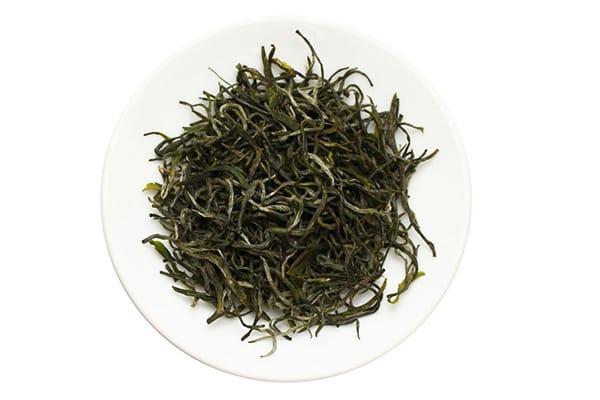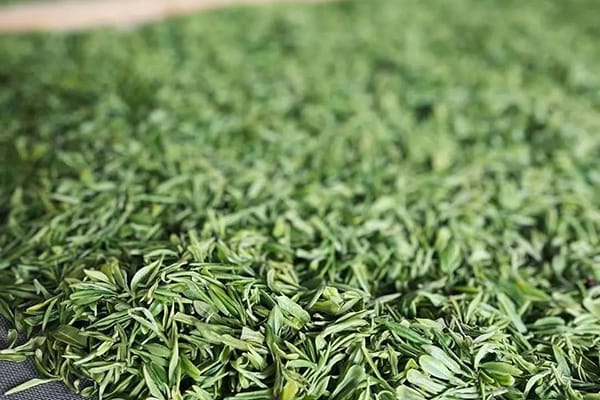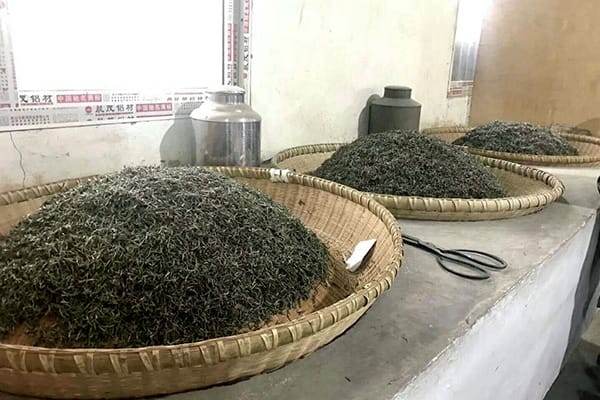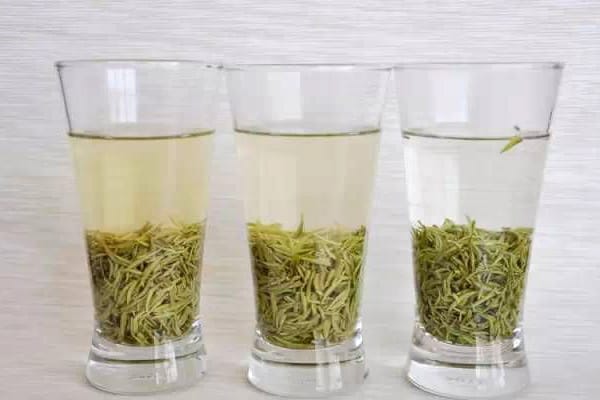Last Updated on 05/16/2021 by Desmond
Henan is the most important birthplace of Chinese culture. As a politics and culture center of ancient China, Henan also has a long history of tea-producing. Nowadays, a famous green tea – Xinyang Maojian tea, is still produced there.
CONTENT
What Is Xinyang Maojian
History
Xinyang Maojian tea is originated in Xinyang city, Henan, which belongs to green tea. People commonly call it “Yu Maofeng;” Yu is Henan for short, and Maofeng is to describe the leaves are covered with much tiny white fuzz.
We know that green tea was prevalent in ancient China, and it reached the top in Tang Dynasty. At that time, Xinyang has already been an essential tea-producing region; the leaves from there were called “Benshan Maofeng.” Due to the excellent quality, it was listed as a royal tribute. But the local tea industry declined a period because of the high tax in Yuan and Ming dynasties.
The story took a turn at the end of the Qing Dynasty.
Some people raised funds and set up eight tea shops. They reclaimed tea plantations and improved the processing methods to boost production. All these made the local tea industry recovered.
In 1915, one of the tea shops won the gold medal in Panama-Pacific International Exposition. Since that, the leaves that originated here were named Xinyang Maojian tea formally.
Producing Regions
There are eight primary tea-producing regions in Xinyang; people call them “five Yun, two Tan, and one Zhai.” (Yun means cloud, Tan means pond, and Zhai means stockade) They are:
- Cheyun Shan
- Jiyun Shan
- Yunwu Shan
- Tianyun Shan
- Lianyun Shan
- Heilong Tan
- Bailong Tan
- Hejia Zhai
Xinyang is located at a high altitude area, with a low annual average temperature, about 15℃. The rainfall is rich, and the sunshine duration is short. That makes the tea trees growing slow, and stay at the tender buds state longer, helps the nutrient accumulate of the leaves.
Camellia Sinensis Types
When we see the name Xinyang Maojian, we may think that the leaves are all made from tender buds. But it is not. Xinyang Maojian refers to green teas that originated in Xinyang, not all of them from the same type of Camellia Sinensis. They are also graded differently by many standards.
The Camellia Sinensis types of Xinyang Maojian is rich; they are mainly classified into 4:
Xinyang Native Species
Xinyang has an over thousands history of tea cultivation. The native species is also called Han Cha. They are retained after a long time screen by nature and artificial, growing in most of the old tea plantations. The native species got a cold-resistant, small leaf, full-fragrance, and robust taste characteristics.
Wuniu Zao Species
The Wuniu Zao species is a Camellia Sinensis type newly introduced in Xinyang in recent years. Some Longjing green tea is also made from this tea tree. Its characteristic is the tender buds are shoot early, typically can be harvested in early March. But due to the plantation time is still short, the products are hard to see on the market.
Fuding Da Bai Cha
Xinyang introduced Fuding Da Bai Cha tea trees in the 1920s. Yes, some Xinyang Maojian got the same source as the Fuding White Tea, so they got more “Hao” on the leaves. This Camellia Sinensis has a poor cold resistance than the native species and suits to be cultivated at the lower altitude. It got a high-yield characteristic, more fuzz on the leaves, a pure aroma, light taste, which is suitable to process into bud tea.
Wild Tea Trees
Some tea masters will find the ancient tea trees in the Xinyang forest to produce tea. The Xinyang Maojian made from these wild leaves is small and thin, with a full aroma. They are appreciated by natural organic food lovers.
Varieties
Xinyang Maojian tea primary classified according to the picking standard:
- Special Grade Maojian: One bud and the early-born first-leaf take over 85%;
- First Grade Maojian: One bud and the first-leaf take over 80%;
- Second and Third Grade Maojian: One bud and to the second-leaf take over 70%;
- Fourth and Fifth Grade Maojian: One bud and to the third-leaf, and the early-born fourth-leaf take over 35%;
Likewise, just like the other teas, Xinyang Maojian is also classified according to the harvest seasons:
Spring Tea
The leaves harvested in spring typically regarded with the highest quality. After a long winter recuperates, tea trees accumulated enough nutrients, plus the comfortable temperature and rainy in spring, the newborn leaves got better flavor and can bring more benefits.
In China, farmers cultivating basic on ancient solar terms theory. So the spring teas are also classified into:
- Mingqian Cha: Leaves harvested before Qingming(typically on 5th, April;)
- Yuqian Cha: Leaves harvested before Guyu(typically on 20th, April;)
- Late Spring Tea: Leaves harvested before the end of May;
Summer Tea
When summer comes, the temperature getting high and the sunshine duration getting longer, the tea trees growing faster. The leaves are mature enough, bigger, and thicker. The tea polyphenols and caffeine content increase, so the summer tea tastes more bitter and can be brewed more rounds.
Autumn Tea
Autumnal is the last harvest season of Xinyang Maojian tea of the year. The left leaves contain lesser nutrition and flavor substances, the fragrance and taste are insipid, with less bitterness and astringency.
Processing
Xinyang Maojian is green tea, so there is no fermentation during the processing; fresh leaves will be finish process in the day. Traditionally, the leaves will be processed into Xinyang Maojian through the following steps:
Placing. Fresh leaves after picking will be placed on a bamboo sieve for 1-2 hours to remove most of the grassy smell.
Fixation. Tea masters will put the leaves in an iron pot, frying them at 140 – 160℃ quickly, cost about 7-10 mins. That makes the leaves stop from natural fermentation and let the water content reduce to about 55%.
Rolling. Reduce the iron pot temperature to 80-100℃, rolling the leaves curled into strips with hands, and make the water content reduce to about 35%. It typically cost 7-10 mins;
First Drying. Leaves will be sent to drying after rolling. The first roast will be at 80-90℃, cost 20-25 mins, the water content reduced to about 15%;
Cooling. Placing the leaves for about 1 hour for cooling;
Re-roasting. Drying the leaves at 60-65℃ again for about 30 mins, reduce the water content to 6-7%. So far, the rough tea is finished;
Sorting. Remove the tea stems, impurity, and low-quality leaves;
Re-roast again. Drying the leaves at 60℃ again for 25-30 mins to get a much lower water content, and leaves can be smashed into powder by finger pinching. The tea will get a more robust aroma at the same time and more suitable for storage;
With the help from the machines, the Xinyang Maojian processing gets simplified now. Most tea factories will skip the last drying step, and the tea also gets a less roast flavor.
Xinyang Maojian Flavor
Due to the different picking standards and tea tree varieties, Xinyang Maojian tea got many flavor types. Typically, the special grade spring Xinyang Maojian is regarded with the highest quality, but the others also have a worth trying; it depends on your taste.
Mingqian Cha. It tastes without or less bitter and an intense sweetness aftertaste, but the price is high. Sometimes, you may meet some leaves frozen in winter; they taste light and even with an obvious astringent.
Yuqian Cha. It tastes a little bitter, the mouthfeel is not as smooth and soft as the Mingqian Cha, but the aftertaste is also sweet.
Late Spring Tea. It is typically made and consumed by the local folks themselves, with a robust roast flavor and astringent, a slightly sweet aftertaste.
Summer Tea. It tastes the strongest, also the astringency is.
Autumn Tea. It is also called Bailu Cha, tastes light, with a soft mouthfeel.
Native Species Xinyang Maojian. It tastes a strong astringent, with a full aroma, resistant to brew, and great aftertaste.
Da Bai Cha Xinyang Maojian. It tastes delicate, with litter sweet and astringent, fresh and brisk.
How To Make Xinyang Maojian Tea
There are many ways to make Xinyang Maojian tea, and they are interesting.
To the high-quality Xinyang Maojian, tea lovers typically will brew it in a normal way. Put 3-5g leaves into a glass cup, add 85℃ water at a ratio of 1:50, steep for about 30 seconds, then enjoy.
But every harvest season comes, many tourists and tea merchants visit Xinyang. The local folks also hospitable, they serve the new teas for the visitors for free.
The most usual scene is that many people with a glass cup on the street and steeping the Xinying Maojian. The leaves and the water ratio is high to 50:50. Gradually, it turns to a popular brewing way, which is regarded as the most authentic. But the infusion made in this way tastes too strong and shows an apparent yellow color, the vast fuzz also makes it look muddy, not fit one who has a light taste.
Making Xinyang Maojian in the 50:50 way, there are 3 sub-methods:
- Put the leaves first, add 1/4 water, steeping for 10 seconds, then go on filling;
- Add 1/4 water first, put the leaves after, then go on filling;
- Adding water first, put the leaves after;
In method 1, the leaves will be pre-heat and moist enough, so the infusion with a higher concentration and a more robust flavor. Method 3 makes the lightest one. You can try it with your taste.
How To Store
Just the same as most green teas, several points should be taken care of during Xinyang Maojian tea storage:
Avoid High Temperature. A high temperature may let the microorganisms left during the processing and the enzyme inside the leaves activate again, leading to ferment and flavor change.
Avoid Damp and Smell. The Xinyang Maojian leaves are relatively dry, especially the ones which re-roast in the traditional processing way. They easily absorb the water and smell in the air, getting damp, and the flavor turns worse. Although a fridge can provide a low-temperature environment, the high humidity inside and the scent from other food seem horrible to the tea; it’s not recommended.
Avoid Sunshine. Green teas are easy to take photochemical reaction, the leaves turn yellow and brown slowly, and the flavor lost. Under direct sunlight long time also brings the high-temperature problem.
Keep Sealed. Typically, the Xinyang Maojian teas sold on the market provided a sealed individual package. If there isn’t, or you had already unwrapped it, you should seal it well again after drinking. Green tea doesn’t been fermenting, and it’s easy to be oxidated.
It’s hard to see people aging the Xinyang Maojian. Except for the aging job is challenging, one characteristic of green tea is the freshness, so the spring tea, especially the Mingqian Cha always at a high price. The Xinyang Maojian dry enough may have a longer storage time, but the best is to finish consuming it ASAP.
